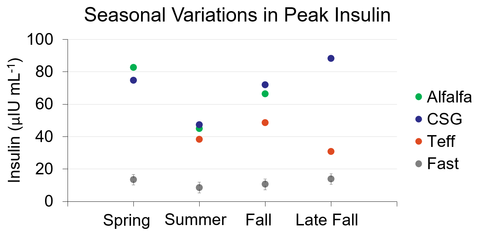Quick facts
- Teff has lower nonstructural carbohydrates (NSC) and higher fiber values compared to cool-season grass and alfalfa.
- When grazed by horses, blood insulin levels were lower for horses grazing teff compared to cool-season grasses in the fall and late fall.
- As a result, the lower NSC and higher fiber values of teff could help decrease the insulin response of horses grazing in the fall and late fall.
Forage is a primary part of the horse’s diet and is often fed in the form of cool-season grasses (e.g. orchardgrass), legumes (e.g. alfalfa) or warm-season grasses (e.g. teff). These forage types differ widely in their nutritional content. Two main differences are the NSC content and fiber. Teff usually has a lower NSC content than cool-season grasses and a higher fiber content than cool-season grasses and legumes.
A lower NSC content and higher fiber values can be beneficial for overweight horses or those diagnosed with conditions such as Cushing’s Disease, insulin resistance or laminitis. These values are important as they may contribute to a lower glucose and insulin response in horses.
The goal of our research was to explore the nutrient values of the forages, including NSC and fiber, and their effects on horses.
Testing forage, blood glucose and insulin
- Six aged horses were grazed on cool-season grass (Kentucky bluegrass and orchardgrass mixture), legume (alfalfa) and warm-season grass (teff) pastures.
- Horses grazed alfalfa and cool-season grass in the spring, all three forages in the summer and fall, and cool-season grass and teff in the late fall.
- During each season, forage and blood samples were taken before turning out the horses and again two, four, six, and eight hours following turnout.
- In addition, the nutrient content of each forage and the glucose and insulin levels in the blood samples were determined.
Results
The forage types each differed in nutrient content during the grazing period (see tables 1 and 2). Alfalfa and cool-season grasses had a higher digestible energy (DE) compared to teff. Teff had lower NSC compared to cool-season grass in the summer and late fall. The fiber levels (ADF and NDF) were highest in teff compared to the other forage types.
A lower NSC content relates to less simple sugars, which can lower the glucose and insulin response in the animal. While we saw no differences in the NSC content of teff compared to alfalfa, the higher DE in alfalfa suggests it would not be suitable for overweight horses.
Fiber plays an important role as well. It can impact the availability of the nutrients and the rate of intake. Decreased availability of nutrients and a lower rate of intake can decrease the quantity and quality of carbohydrates consumed.
Table 1. The nutrient content of forage grazed by horses in May and July 2016.
| Spring | Summer | |||||
|---|---|---|---|---|---|---|
| Nutrient | Alfalfa | Cool-season grass | Teff | Alfalfa | Cool-season grass | Teff |
| DE, Mcal kg-1 | 2.3 | 2.17 | - | 2.29 | 2.24 | 2 |
| NSC, % DM | 9.9 | 10.6 | - | 9.8 | 11.3 | 8.4 |
| NDF, % DM | 46.2 | 55.9 | - | 46.3 | 52.9 | 67 |
| ADF, % DM | 34.9 | 31.6 | - | 34.8 | 30.3 | 37.1 |
Table 2. The nutrient content of forage grazed by horses in September and late October 2016.
| Fall | Late Fall | |||||
|---|---|---|---|---|---|---|
| Nutrient | Alfalfa | Cool-season grass | Teff | Alfalfa | Cool-season grass | Teff |
| DE, Mcal kg-1 | 2.51 | 2.18 | 2.03 | - | 2.37 | 2.36 |
| NSC, % DM | 8.6 | 9.9 | 7.9 | - | 13 | 8.3 |
| NDF, % DM | 36.9 | 55.4 | 63.3 | - | 47.9 | 46.3 |
| ADF, % DM | 28.7 | 31.4 | 36.8 | - | 27.1 | 31.5 |
Horses grazing teff had a lower average glucose and insulin content in the late fall and a lower peak insulin content in the fall and late fall when compared to horses grazing cool-season grass (see figure 1).
Lower glucose and insulin values are beneficial for horses who are overweight, have insulin resistance, or have a history of laminitis or tying up. While glucose and insulin values were not different in the spring and summer, glucose and insulin values were lower for horses grazing teff in the fall and late fall compared to horses grazing cool-season grasses.
Reviewed in 2021


